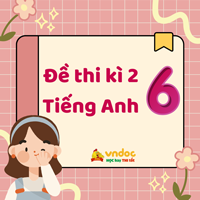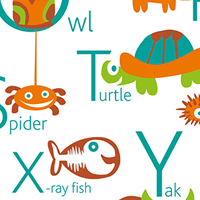Đề thi học kì 2 lớp 8 môn Tiếng Anh có file nghe năm 2022 - 2023 số 2
Đề thi cuối kì 2 lớp 8 môn tiếng Anh có file nghe và đáp án chi tiết nằm trong bộ đề ôn thi học kì 2 lớp 8 năm học 2022 - 2023 do VnDoc.com sưu tầm và đăng tải. Đề kiểm tra Tiếng Anh lớp 8 học kỳ 2 có đáp án gồm nhiều dạng bài tập Tiếng Anh thường gặp trong đề thi chính thức giúp học sinh lớp 8 nâng cao kỹ năng làm bài Tiếng Anh hiệu quả.
Đề thi tiếng Anh lớp 8 học kì 2 có file nghe + đáp án
Tham khảo thêm: 8 Đề thi tiếng Anh lớp 8 học kì 2 có đáp án năm 2022
I. Đề thi tiếng Anh lớp 8 cuối kì 2 năm 2022 - 2023
I. LISTENING
Click để nghe
1. Listen to Son and Peter talking about the most important inventions of the 21th century. Fill each of the gaps with no more than THREE words and/or a number. You will listen TWICE.
Youtube | Google Driverless Car | ||
Year of invention | (1) ______ | (2) ______ | 2012 |
Usage | It (3) ______ 1.6 billion people around the world. | World most popular (4) _______. | Change the way people (5) ______ the city. |
2. Listen to Annie talking about the Internet. Decide if the statements are true (T) or false (F). Circle T or F. You will listen TWICE.
1. Annie thinks the Internet is the greatest invention. | T | F |
2. Annie does her homework on the Internet. | T | F |
3. Annie loves emails. | T | F |
4. Annie spends little time on the Internet. | T | F |
5. Annie puts a lot of her personal information on Facebook. | T | F |
II. READING
1. Read the passage and answer the questions. Circle A, B, or C.
Most of us think that great ideas were the result of genius thinking. However, many of the greatest discoveries and inventions in history began with very simple beginnings.
In the 18th century, James Watt was boiling water at home. As the water began to boil, he suddenly noticed that the steam was pushing the lid of the kettle. From this, he created the steam engine.
In ancient Greece time, Archimedes stepped into a bath tub and felt that water was being pushed out when he stepped in. This is how he came up with the idea of how to find the purity of gold.
In the 17th century, Isaac Newton was sitting under a tree when an apple fell and hit him on the head. This is when he realized the pulling force of the earth - the gravity.
There are many other examples of how great ideas began with simple beginnings. What one needs to become an inventor are careful observation and a lot of hard work.
1. James Watt lived in ______.
A. the 17th century
B. the 18th century
C. the ancient Greece time
2. Archimedes came up with the idea of how to find purity gold when ______.
A. he was boiling water
B. he was hit by an apple
C. he was stepping into the bath tub
3. Many great ideas began with ______.
A. genius thinking
B. simple beginnings
C. long time working in laboratories
4. Which of the following is NOT true of inventors?
A. They have simple thinkings.
B. They have very careful observations.
C. They work extremely hard.
5.Which of the following can be the best title for the passage?
A. James Watt, Archimedes and Isaac Newton.
B. Steam Engines, Gold and Gravity
C. Great Ideas with Simple Beginnings
2. Read the passage and complete the sentences. Circle A, B, or C.
Giving positive nonverbal messages can improve your relationship with your child and develop emotional connections in your family. Most children love being hugged and kissed, for example. This warm and caring body language sends the nonverbal message that you want to be close to your child.
Some children with special needs – for example, children with autism and sensory sensitivities –might find body contact difficult.
On the other hand, negative nonverbal communication – for example, a grumpy tone of voice or a frown – when you’re doing something fun together might send the message that you don’t really want to be there.
So matching your verbal and nonverbal communication makes your words more effective. For example, a teacher might explain a maths problem using her hands to show size and shape.
But when verbal and nonverbal messages don’t match, your child might believe the nonverbal – after all, what you see is what you get. Your child learns a lot about nonverbal communication by watching you. For example, if you approach new people in a relaxed way, your child is more likely to do the same.
1. A hug or a kiss sends the message that __________.
A. I want to be loved
B. I want to be near
C. I want to be emotional
2. Children with autism and sensory sensitivities find it hard to __________.
A. love
B. communicate
C. contact physically
3. A frown sends the message that __________.
A. I don’t want you
B. I want to be near
C. I don’t really want to join
4. __________ makes words more effective.
A. Using positive actions and body language
B. Combining verbal and nonverbal communication
C. Explaining a problem using body language
5. The best way for children to learn nonverbal messages is through __________.
A. observation
B. communication
C. immitation
III. WRITING
1. Complete the second sentence so that it means the same as the first. Use the word in brackets. You may need to change the word.
Here is an example.
0. The bookshop is opposite the library.
_________________________ a bookshop opposite the library. (THERE)
Answer: There is
1. The English speaking countries exhibition finishes at 8p.m. (END)
_________________________________________________________
2. How long is the presentation? (LAST)
_________________________________________________________
3. The photo session takes place in the library. (HOST)
_________________________________________________________
4. What time does the HN302 leave? (DEPARTURE)
_________________________________________________________
5. A kilt is the traditional garment for Scottish men.(TRADITIONALLY)
_________________________________________________________
2. Now write an email (90-110 words) to your pen friend telling him about an activity that you have done to protect the environment.
You should use the following questions as cues:
- What have you done?
- When did you start it?
- How does it help protect the environment?
- How do you feel?
Hi Charles,
II. Đáp án Đề kiểm tra học kì 2 môn tiếng Anh lớp 8
I. LISTENING
1. Listen to Son and Peter talking about the most important inventions of the 21th century. Fill each of the gaps with no more than THREE words and/or a number. You will listen TWICE.
1. 2000
2. 2005
3. connects
4. video-sharing website
5. move around
2. Listen to Annie talking about the Internet. Decide if the statements are true(T)orfalse (F). Circle T or F. You will listen TWICE.
1. T 2. F 3. T 4. F 5. F
II. READING
1. Read the passage and answer the questions. Circle A, B, or C.
1. B 2. C 3. B 4. A 5. C
2. Read the passage and complete the sentences. Circle A, B, or C.
1. B 2. C 3. C 4. B 5. A
III. WRITING
1. Complete the second sentence so that it means the same as the first. Use the word in brackets. You may need to change the word.
1. The English speaking countries exhibition ends at 8p.m.
2. How long does the presentation last?
3. The library hosts the photo session.
4. What is the departure time of the HN302?
5. Traditionally, Scottish men wear kilts.
2. Now write an email (90-110 words) to your pen friend telling him about an activity that you have done to protect the environment.
Gợi ý
Hi Charles,
There are many different activities I have done to protecting the environment.
One activity that people often do to protect the environment is to participate in community clean-up events. This could involve volunteering to clean up a local park, beach, or other public space to remove litter and other debris. By doing so, people can help prevent this trash from harming local wildlife or entering the water supply, and keep the area looking clean and beautiful for everyone to enjoy.
Best friend,
VnDoc
Tải trọn bộ nội dung đề thi, đáp án và file nghe mp3 tại đây: Đề thi học kì 2 lớp 8 môn Tiếng Anh có file nghe năm học 2022 - 2023 có đáp án số 2. Mời bạn đọc tham khảo thêm nhiều tài liệu ôn tập Tiếng Anh lớp 8 cả năm khác được cập nhật liên tục trên VnDoc.com khác.











